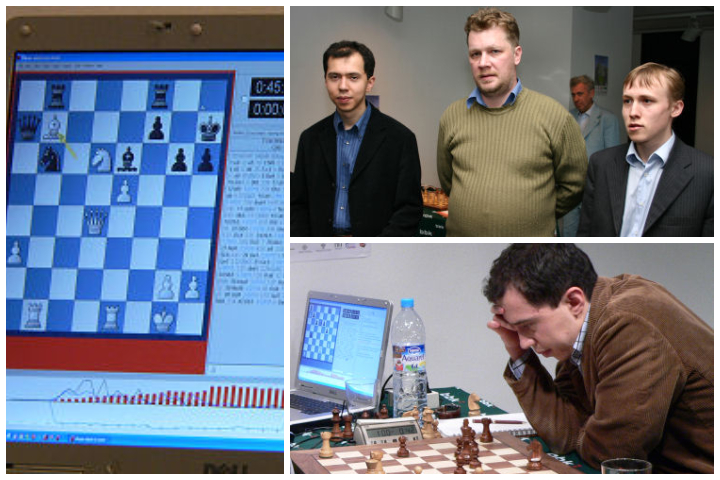An 8-4 victory for the machines
Read full ChessBase reports on the event: Day 1 | Day 2 | Day 3 | Day 4
Bilbao 20-23 November 2005
This was the second time the city of Bilbao in the north-west of Spain was paying host to a man versus machine team encounter. The opponents were three former FIDE world champions: Alexander Khalifman, who won the title in Las Vegas in 1999; Ruslan Ponomariov, who took it in 2002; and Rustam Kasimdzhanov, who unexpectedly won the title in Tripoli in 2004, beating Ivanchuk, Grischuk, Topalov and Adams in the process.
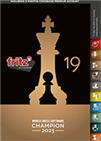 Attacker, coward, swindler or endgame wizard: I'll show you how to win against anyone! After my World Championship victories in 2022 and 2023, I am the reigning Chess Software World Champion and am now looking forward to showing you how to become even stronger against your opponent. With my innovative training method, I simulate typical player personalities you know from tournaments and online chess: brash attackers, cautious cowards, passive players. But how do you win against them? Fritz will show you how!
Attacker, coward, swindler or endgame wizard: I'll show you how to win against anyone! After my World Championship victories in 2022 and 2023, I am the reigning Chess Software World Champion and am now looking forward to showing you how to become even stronger against your opponent. With my innovative training method, I simulate typical player personalities you know from tournaments and online chess: brash attackers, cautious cowards, passive players. But how do you win against them? Fritz will show you how!The computer opponents were the following three machines:
Hydra, the hardware project that was being developed in Abu Dhabi, was installed on 32 processors of a 64 processor array. Each processor had a special purpose of hardware enhancement, a super-fast FPGA chip that executed a critical part of the search and the end node evaluations. The entire system ran at around 1.5 million nodes per second. Why only 32 processors, we asked Dr Donninger? “Because Hydra was optimised for that number”, he replied. “I originally defined ‘any number of processors’ to equal 32, but we are rewriting the program to make it equivalent to 128”.
Deep Junior ran on a very fast dual core AMD machine, located in California. Why there? Amir Ban: “Because the weather is so good”. Junior consistently searched through over six million positions per second on the machine. Both Hydra and Deep Junior were connected to the playing room in Bilbao via the Internet.
Fritz 9 was at the time the latest build of the Fritz 9 program engine, which the authors named ‘Fritz Bilbao’. The program was written by Frans Morsch and Mathias Feist, and the latter operated the machine in this event. Mathias took a notebook from the ChessBase office, but discovered that Frederic Friedel’s Dell Inspiron with its 2.0 GHz Centrino and 750 MB RAM was about 15 percent faster. So he confiscated the machine, installed the new engine on it and used it for the games. Fritz ran at around 1.6 million positions per second on the chessbase.com reporting machine.

The Bilbao Opera, one of many beautiful historical buildings in the Spanish city
Round 1: 3-0 shock start by computers
By David Levy
The game that many people believed would give mankind its best chance against the silicon monsters was Hydra vs Kasimdzhanov. The opening was a King’s Indian Defence in which Hydra played a variation with a blocked pawn centre, not particularly wise against a strong human player.
The battle soon revolved around the question of which would be the most formidable — Hydra’s pressure on the Q-side or Kasimzhanov’s K-side attack. The program did not appear to have any sort of plan, other than securing a strong-looking knight on b5, which eyed the black pawn on a7 and thereby tied Kazim’s a8 rook to a defensive role.
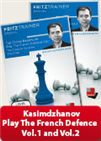 In this two-volume video course former world-champion and startrainer Rustam Kasimdzhanov shows you the ins and outs of this hugely complex opening.
In this two-volume video course former world-champion and startrainer Rustam Kasimdzhanov shows you the ins and outs of this hugely complex opening.Meanwhile, Kasim’s K-side attack grew more and more menacing, until eventually there were six, yes SIX Black pieces bearing down on the white king: two rooks, the queen, two bishops and a knight. Black’s only problem appeared to be that in order to bring the sixth of these pieces into the attack, Kasim had to move his a8 rook away from the defence of the a7 pawn, allowing Hydra to capture that pawn.
Then all hell broke loose on the K-side, as Kasim completed the advance of his g-pawn, leading to a position with a semi open g-file on which he had already piled up his queen and both rooks in an attempt to break through with a mating attack. But even as Black’s pieces were springing to life and approaching Hydra’s king, move after move Hydra was seen to have magical resources to fend off the attack and to encroach into the heart of Black’s position.
The more Kasim tried to prosecute his attack against Hydra’s king, the more hopeless it seemed for Black. Eventually it became clear that Hydra’s judgement had been correct, and the capture of the a7 pawn was sound. After the game, Kasim discussed the possibility of delaying the rook move from a8, preparing his attack for a few more moves and only then giving up the a7 pawn. But that is an idea for another day.
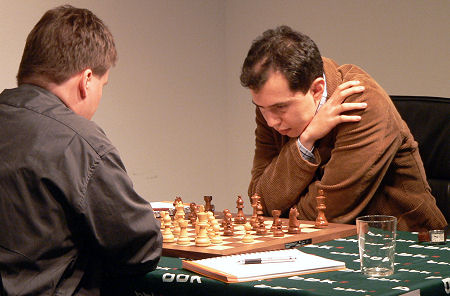
Fritz vs Khalifman was more one-sided. As White, Fritz achieved a pleasant looking position from the Ruy Lopez, side-stepping the challenge of the Berlin Defence by choosing a plan based on the quiet move d2-d3. Khalifman was never able to equalize, while Fritz squeezed and squeezed until Khalifman was forced to saddle himself with an isolated a-pawn. From then on the game looked relatively easy for Fritz, constantly building pressure against that pawn until it fell, leaving the program needing only to demonstrate its technique in order to convert the extra pawn into the full point.

During the opening stages of Ponomariov vs Junior I had the suspicion that Ponomariov had prepared a kind of anti-computer strategy at home and was merely following his preparation. White’s pieces did not achieve a harmonious development, but nevertheless the program’s position appeared to have some inherent weaknesses — its Q-side pawns did not appear to be comfortably placed and Black also appeared to be slightly vulnerable along the h1-a8 diagonal. But it turned out that there was no way for Ponomariov to capitalize on Black’s Q-side pawn structure. On the contrary, White’s minor pieces were beginning to show signs of being poorly co-ordinated.
As the game developed it was soon Junior who was making all the running. The program’s pieces soon sprang to life, allowing a tactical shot that put Ponomariov very much on the defensive. White’s king was somewhat vulnerable, being exposed and subject to irritation from the program’s pieces, while although Junior’s own king appeared superficially to be none too safe, it turned out that there was no way for Ponomariov to take advantage. Eventually, when the dust settled, Ponomariov was compelled to shed a pawn in order to extricate his king from trouble, and then another pawn fell, and a third, giving the computer team a 3-0 sweep on the first day of the match.
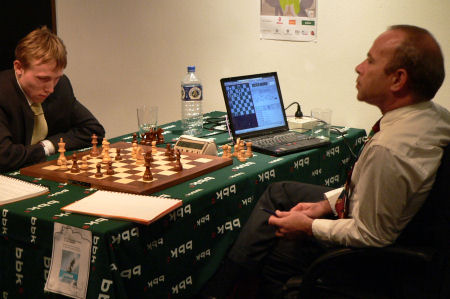
Select an entry from the list to switch between games
Round 2: The humans strike back
By David Levy
What an amazing day. Early in the session, it looked as though the human players might reverse the score of yesterday, taking advantage of having the white pieces on all three boards. Khalifman achieved a very slight edge from the opening, Kasimdzhanov secured a bigger advantage against Junior’s Sicilian Defence, and Ponomariov was a pawn up after only six moves when Fritz unwisely decided to sacrifice in return for a few tempi in development.
The Ponomariov vs Fritz game was a real see-saw. Fritz had not understood, when sacrificing its b7 pawn, that it was playing just the type of position in which tempi do NOT provide adequate compensation for a pawn. As a result, Ponomariov soon appeared to be consolidating his extra material without much difficulty, and it seemed as though converting this into a win was “only a matter of technique”, as they say. And as the game wore on, the score indicator on Fritz’ monitor was uniformly red, indicating that the program was consistently unhappy with its position.
But then something extremely bizarre happened. Ponomariov advanced his g-pawn from g2 to g4, attacking Fritz’ queen and believing that the queen had to move away to safety, in which case the GM’s position would have been overwhelming. But as the pawn reached g4 Ponomariov froze, his hand still on the piece for a full fifteen seconds or more. What he had suddenly remembered, to his horror, was that Fritz’ pawn on h4 could capture en passant – the former World Champion had simply forgotten one of the rules relating to how the pieces move. But having touched the g-pawn there was nothing to be done. He could of course have retreated it a square to g3, but with the same result.
Fritz expressed great delight in making the en passant capture by suddenly changing the colour of the score bar on the monitor, from a long red line to a long green one — i.e. Fritz’s method of saying to the world, “Don’t I have a great position”.
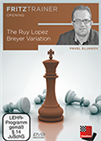 Pavel Eljanov explains in depth what Gyula Breyer already saw in 1911 and what became an opening choice of the likes of Kasparov, Kramnik, Anand or Carlsen. The Breyer Variation, which is characterised by the knight retreat to b8.
Pavel Eljanov explains in depth what Gyula Breyer already saw in 1911 and what became an opening choice of the likes of Kasparov, Kramnik, Anand or Carlsen. The Breyer Variation, which is characterised by the knight retreat to b8.At that moment Ponomariov wanted to resign. But somehow he kept his composure and struggled on for a few moves, his position collapsing around him both on the K-side, with the incursion of Fritz’ queen, and on the opposite flank, when Fritz’ rook cashed the white c-pawn, opening the c-file which it now controlled.
The spectators were expecting Ponomariov to capitulate at any moment, but then fate took a hand in the proceedings. Fritz found a move, 39…Bc2, which was clearly winning — but for one thing, it actually lost! This is one of the fascinations of computer chess. When you play through this game, take a look at the forced sequence commencing with Fritz’s …Bc2, and count how many ply there are from there to the position when Matthias Feist resigned on Fritz’ behalf. Then add a few more ply because, in the final position, although Black will inevitably be saddled with a decisive material deficit, at that moment the program still had two minor pieces for a rook. So the depth to which Fritz would have needed to search in the critical variation, in order to realise that …Bc2 was a losing move rather than a winning one, was quite beyond the program’s capability.
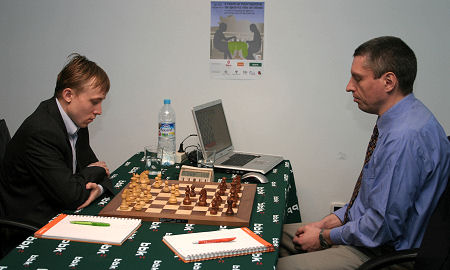
While all this high drama was unfolding, neither Khalifman nor Kasimdzhanov were able to see their advantages grow, so those two games were drawn. With the programs’ lead cut from 3 points to 2, and with the grandmasters demonstrating most emphatically that they are not feeling devastated as a result of yesterday’s drumming, there is still everything to play for.
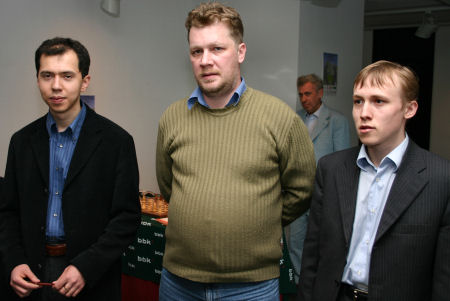
Select an entry from the list to switch between games
Round 3: Wham! 2½-½ for the machines
By David Levy
Wham! The programs all had white today and reasserted themselves, coming close to achieving a whitewash. Two of the games saw the grandmasters rapidly achieving a blocked centre, a type of position in which programs typically play rather poorly, with Kasimdzhanov essaying the Caro-Kann against Fritz, while Ponomariov transposed into a French Defence.
The first game to reach a climax was Hydra vs Ponomariov, in which the Ukranian genius once again forgot one of the rules relating to how the pieces move, the one we call “castling”. Instead of attempting to move his king to the Q-side in a single shot, and at the same time bringing his a8 rook into play, Ponomariov came up with the bizarre looking idea of 11…Kd7, followed by 13…Kc7 and later 18…Kb7?, a horrible looking manoeuvre.
No sooner had his king reached b7 than the roof caved in — Hydra found the shot 19.Nde4! which allowed the second of his knights to wade into Ponomariov’s centre (one was already on f6) and dominate the position from the d6 square. 19...Ka7. If Ponomariov had captured the knight with 19…dxe4, Hydra would have won at once with 20.d5 Nxe5 (20...Nd8 21.d6+-) 21.Qxe5. But what Ponomariov actually played was not much better, and the game lasted only another eight moves.
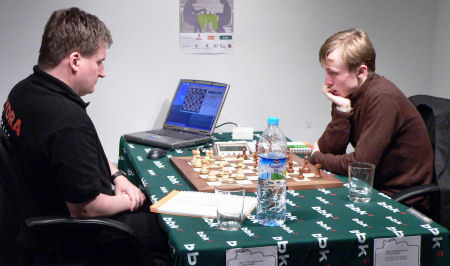
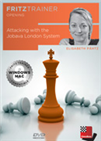 The Jobava London System is a minor form of the London System. White tries to play Lf4 quickly followed by Nc3.
The Jobava London System is a minor form of the London System. White tries to play Lf4 quickly followed by Nc3.Junior vs Khalifman was a textbook example of how to play the white side of the Ruy Lopez. As in his round one game on the black side of this opening, Khalifman was steadily squeezed, very slowly indeed. A position was reached in which material was reduced to a queen and four minor pieces each, but with Junior having a very modest advantage in mobility. This slight advantage proved sufficient for a win, but only after Junior demonstrated a superlative technique, creating a passed pawn on the Q-side and then using this pawn to force Khalifman to give up a knight.
After the game, Khalifman said he was amazed that a program could play such a position so well, likening Junior’s play to Karpov at his very best.
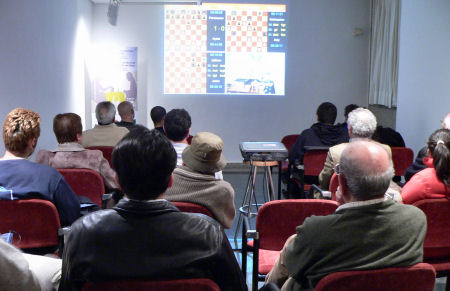
The most exciting game of the round by far was Kasimdzhanov vs Fritz. For a while, it appeared as though Kasimdzhanov had set up a successful K-side defensive structure, with a knight on f5 and a pawn on h5. When Fritz played 10.Nd1, it may have been possible for Black to advance with …g5, and to meet Ne3 with …g4 (e.g. Nxf5 gxf3; Nxe7 fxg2). But Kasimdzhanov was determined to take no unnecessary risks and, as a result of his caution, his position suddenly became critical.
As the game developed, Kasimdzhanov eventually castled Q-side and started some sort of attack along the g-file, aiming at the program’s king. Meanwhile, Fritz opened up the position somewhat with c4, and created the makings of a promising looking attack against the black king. For several moves, the game was balanced on a knife edge, with both players seeming to have excellent prospects at various moments.
Just as the spectators were expecting an aggressive queen manoeuvre from Fritz, to a3 or c3, the program instead slid its king to h1, which might have been a waste of a vital tempo (though a cursory analysis by Fritz suggests that neither Qa3 nor Qc3 would have been superior). This king move allowed Kasimdzhanov to gain some counterplay by sacrificing the exchange, and at the same time to trade queens.
The resulting endgame was even more unclear than most of the middlegame had been, with the program having a protected passed pawn on a7, another passed pawn racing up the h-file, and a third pawn (the g-pawn) creating obscure tactical chances. To add to his worries, Kasimdzhanov was getting a little short of time in the “guillotine” segment of the time control (the rate of play is 40 moves in 2 hours followed by all remaining moves in 1 hour). Nevertheless, he was quickly advancing his own passed pawns on the b- and c-files, and beginning to activate his knight.
Fritz decided to cash in the benefits of its passed pawns, winning Black’s remaining rook in the process, creating a material situation with two rooks (Fritz) against a knight and three pawns. At this point, the program had begun to access its endgame tablebases and was returning a score of zero. Kasimdzhanov was down to less than seven minutes for all his remaining moves, and Mathias Feist sportingly offered a draw on Fritz’s behalf, which Kasmizhanov thought about for a couple of minutes before accepting.
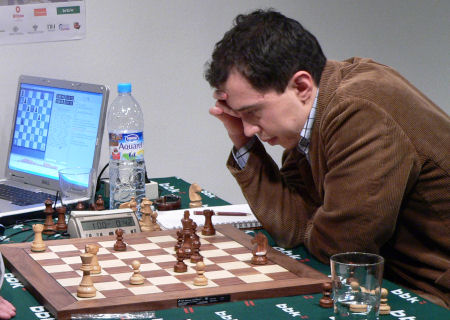
Select an entry from the list to switch between games
Round 4: 8-4 final score
By David Levy
This was a better day for the grandmasters than they were expecting. Khalifman as white obtained the tiniest of advantages out of the opening, and looked to be attempting to take control of the d-file which, if he had been able to do so, would have given him a definite plus. But not only did Khalifman find it impossible to seize the d-file, he ended up conceding it to Fritz, which then subjected him to abject torture. Eventually an endgame was reached in which Khalifman was compelled to sacrifice his last remaining piece, and he drew the game by the skin of his teeth. Such is life these days, even for a former World Champion, when playing one of the world’s top computer programs.
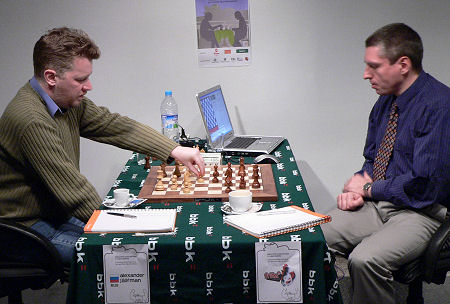
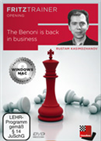 On top level the Benoni is a rare guest but with this DVD Rustam Kasimdzhanov this might change. New ways and approaches in most lines and countless improvements of official theory will show you how to play this opening at any level with success.
On top level the Benoni is a rare guest but with this DVD Rustam Kasimdzhanov this might change. New ways and approaches in most lines and countless improvements of official theory will show you how to play this opening at any level with success.Kasimdzhanov was definitely better against Hydra, obtaining a Maroczy bind type of position after the opening transposed into some sort of Sicilian. But Hydra defended extremely tenaciously, and piled up its pieces to overprotect the d5 square. As every Russian schoolboy knows, if Black can play the freeing break …d5 in the Sicilian, then his position is fine. Hydra duly managed …d5, and although Kasimdzhanov later had some attacking prospects on the K-side, it would have been too risky to attempt to advance on that wing, and Kasim therefore decided to settle for a draw by repetition.
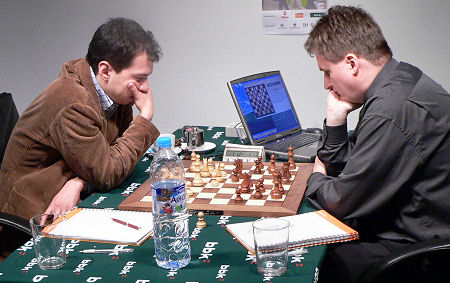
By far the longest game of the day, and of the whole event, was Junior’s ridiculous attempt to win against Ponomariov, from a Winawer variation in which the centre (and much of the remainder of the board) was completely closed. By move 18 the stage was set for a quick shaking of hands. But Amir Ban, operating Junior, saw that his program assessed the position as being slightly better for White, and therefore wanted more. For almost 50 moves, no pawn was pushed and no piece taken, while Ponomariov moved a couple of his pieces back and forth ad nauseam.
But then, just as everyone in the playing hall was about to fall asleep with boredom, Junior advanced its f-pawn to f3, and then to f4. This appeared to give new life to Ponomariov, or perhaps he was just incensed at the fact that Amir had not offered a draw. Whatever the reason, Ponomariov now started to play for a win for the first time in the game (and this was around move 70).
First Ponomariov appeared to be better, with the program’s king looking somewhat exposed in the centre, but then the tables turned and it was clear that Pono was very much on the defensive, and then they turned just one more time to give Pono a reason to play for a win again, with a knight against the program’s not very wonderful bishop. Just when Junior was getting rather short of time, in the final “guillotine” session of the time control, the players repeated moves and the game was over.
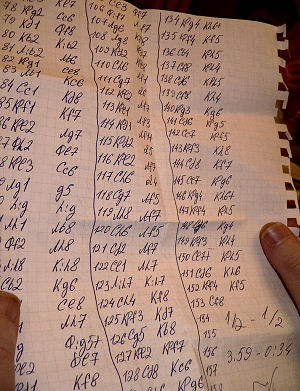
Select an entry from the list to switch between games
Links
